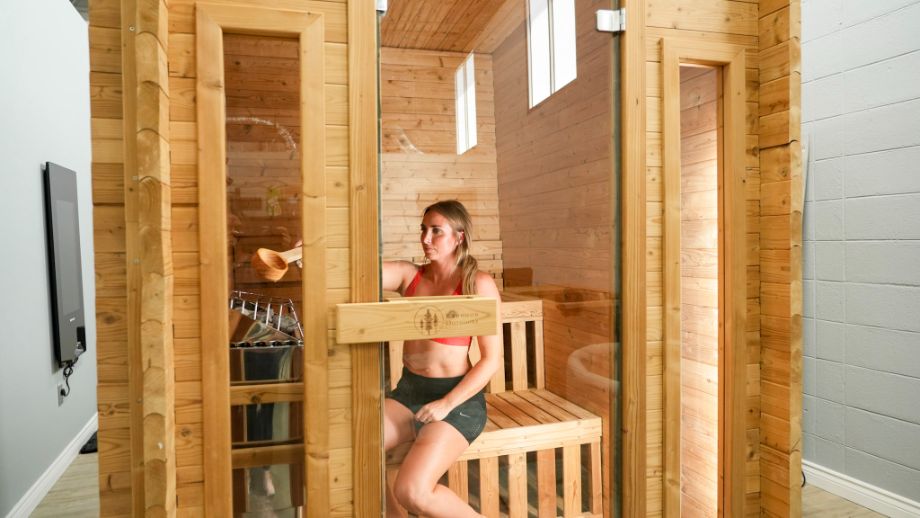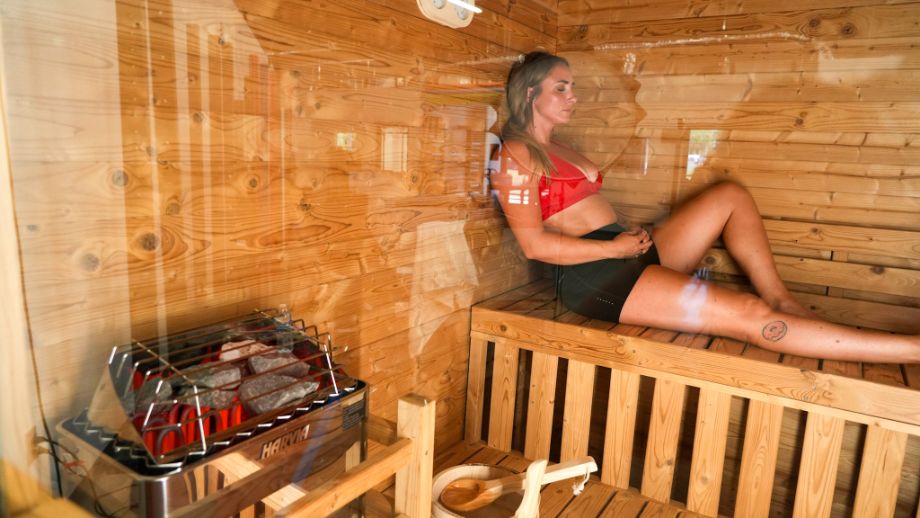We test and review fitness products based on an independent, multi-point methodology. If you use our links to purchase something, we may earn a commission. Read our disclosures.
Nothing beats a nice sit-down in one of the best home saunas or steam rooms after a grueling workout. It feels great to get out of those wet workout clothes, grab a towel (or go au naturale!), and let the heat exposure soothe your sore muscles as you let yourself unwind.
Regular sauna bathers enjoy more than just a little heat and some peace of mind; there are a multitude of health benefits associated with sauna bathing. Today, we’ll discuss all things sauna with Sydney Lappe, R.D., covering different types of saunas, benefits and risks of sauna usage, and much, much more!
We’ll also answer one of the most common questions regarding sauna use:
Does the sauna burn calories? Read on to find out!
Medical disclaimer: This article is intended for educational and informational purposes only. It is not intended as a substitute for medical advice. For health advice, contact a licensed healthcare provider.
“The sauna is by no means a substitute for exercise or eating right, but it can be part of a broader picture and ultimately contribute to better health and wellness.”
Sydney Lappe, registered dietitian
How Saunas Work
Some scientists speculate that sauna use dates as far back as 4000 B.C., based on a recent discovery in the Scottish Orkney Islands, but Finland often is given credit for inventing the first saunas. The Finnish people would dig holes, construct a fireplace, and use it to heat stones to high temperatures.
Modern saunas operate similarly; a traditional sauna uses dry heat, which is created using a wood-burning stove or electric heater that heats stones just as ancient saunas did. Typically, temperatures range between 160 and 200 degrees Fahrenheit.
A steam room uses comparatively low temperatures, ranging from 110 to 120 degrees, but the humidity is very high. Steam rooms offer some benefits that dry saunas do not, but more studies have focused on dry saunas, providing them with a proven track record.
RELATED: Steam Room Vs Sauna
Most high-end commercial gyms offer one or both of these sauna types, but there is another type that is relatively new. Invented in 1965, the infrared sauna uses infrared light to raise your body temperature without heating the air around you.
Infrared saunas tend to be equally effective as traditional saunas, but more efficient since they don’t have to heat the whole area to provide you with the same effect.
RELATED: Infrared Sauna Benefits

Can You Burn Calories in the Sauna?
Are you sitting down while you’re reading this?
If so, you’re already burning between 68 and 94 calories per hour, according to Harvard Health1. The question is: Does sitting in the sauna burn more calories than sitting at room temperature?
“The high heat of the sauna raises your body temperature, elevates your heart rate, and improves blood flow,” says Sydney Lappe, registered dietitian. “These physiological responses to the heat can lead to a higher calorie burn, especially compared to sitting at room temperature.”
A study in BioMed Research International2 found that consecutive 10-minute sessions in a traditional Finnish sauna, with 5-minute cooldowns between each of the four sauna sessions, increased energy expenditure and compounded the calorie-burning effect.
Participants burned approximately 73 calories in the first session, torching 150 calories by the last session. Researchers observed changes in the participants’ physiological parameters, too, including changes to body fat percentage, total mass, and BMI.
As with most physical activities, the number of calories you’ll burn depends on various factors, including your body weight, age, total muscle mass, and biological sex.
“Relying solely on sauna use in hopes of losing weight might not meet your expectations. But combining sauna bathing with regular exercise and a healthy diet can help you meet and sustain your weight loss goals.”
Sydney Lappe, registered dietitian
Another study, published in The Scientific World Journal3, found that “the greatest [body mass loss] was reported in overweight and obese subjects,” giving credence to the fact that sauna use may be beneficial for overweight, obese, and sedentary individuals looking to lose weight.
“Relying solely on sauna use in hopes of losing weight might not meet your expectations,” Sydney cautions. “But combining sauna bathing with regular exercise and a healthy diet can help you meet and sustain your weight loss goals.”
Sauna Benefits
The sauna helps you burn some extra calories, but that’s not all. There are a ton of additional perks that make it even more than worth your while. Here are a few dry sauna benefits.
Eliminates Toxins and Excess Water Weight
You don’t have to be a doctor or scientist to notice yourself sweating while sitting in the sauna.
Sweating serves many purposes. It’s the human body’s biological response to extreme heat, as it provides a cooling effect to help regulate our skin, body, and core temperatures and prevent overheating. Sweating also eliminates excess water weight, reducing bloating and puffiness.
But that’s not all; according to a 2022 study in the International Journal of Environmental Research and Public Health4, sweating also purges toxins and heavy metals, including nickel, lead, copper, arsenic, and mercury, from the body.
So, spending time in the sauna provides detoxification effects and reduces excess water weight.
May Improve Heart Health
Studies show that the sauna is helpful for heart health, too.
According to BMC Medicine5, “higher frequency and duration of sauna bathing are each strongly, inversely, and independently associated with fatal [cardiovascular disease] events.”
Another study6 expanded on the topic, further supporting the theory that sauna use may reduce heart disease mortality risk while also that it may have a positive effect on both resting and systolic blood pressure.
May Help Improve Cholesterol Levels
“Leading a healthy lifestyle—such as maintaining a healthy weight, exercising regularly, and eating a healthy diet—typically has the most significant impact on improving your lipid profile,” Sydney explains. “However, studies also show that sauna bathing can positively affect your lipid profile.”
In fact, a 2014 study published in the International Journal of Occupational Medicine and Environmental Health7 observed “a reduction in total cholesterol…LDL cholesterol…[and] triacylglycerols,” all of which are effects that the average person would receive from exercising at moderate intensity.
“The sauna is by no means a substitute for exercise or eating right,” says Sydney, “but it can be part of a broader picture and ultimately contribute to better health and wellness.”
Enhances Muscle Recovery and Performance
Heat therapy is often used to soothe sore muscles after a strenuous workout. Saunas, along with heated gel packs, heating pads, and hot tubs, serve as a means for delivering heat therapy to those aching muscles and work as one of the best muscle recovery tools.
According to a 2023 study published in Biology of Sport8, athletes exhibited improved sport performance, reduced muscle soreness, less inflammation, and an enhanced mindset after a single 20-minute session sitting in an infrared sauna.

May Improve Sleep
Sitting in the sauna works wonders for your physical health, but it’s also invaluable for promoting relaxation and reducing stress levels. This combo is a recipe for better sleep, and studies show that you may enjoy more restful sleep from regular sauna bathing.
A 2019 study published in Complementary Therapies in Medicine9 surveyed nearly 600 regular sauna bathers, discovering that “83.5% reported sleep benefits after sauna use.” Respondents also cited they enjoyed improved health and well-being while experiencing “relatively few adverse effects.”
Sauna Side Effects
Seasoned sauna bathers swear they can sit in there for hours at a time, but we’d caution against exceeding a half-hour due to the risks and adverse effects associated with sauna use.
Here are a few risks and adverse effects associated with sauna use.
Dehydration
“Dehydration is the most common adverse condition associated with sauna use,” warns Sydney. “I always recommend keeping a water bottle handy for before, during, and after your session.”
Symptoms of dehydration10 include:
- Thirst
- Fatigue
- Dizziness
- Lightheadedness
- Dark-colored urine
- Strong-smelling urine
- Urinating less or less often
If you experience any of these symptoms, end your session and drink water immediately.
Electrolyte Imbalance
Sweating profusely also can lead to an electrolyte imbalance11, which can “disrupt normal bodily functions” and “lead to life-threatening complications.”
Symptoms of an electrolyte imbalance include:
- Confusion
- Irritability
- Diarrhea
- Constipation
- Headaches
- Fatigue
- Nausea
- Vomiting
- Muscle cramps, aches, or spasms
- Irregular or elevated heart rate
- Numbness or tingling in limbs, fingers, or toes
“Drinking one of the best electrolyte drinks helps ensure you replenish electrolytes as you sweat,” recommends Sydney, “but many foods provide a natural way to replenish electrolytes too, including bananas, coconut water, watermelon, and avocado.”
Elevated Heart Rate
Generally speaking, sauna use reduces your risk of experiencing a fatal cardiovascular event.
However, since saunas elevate your heart rate during use, they could pose a risk to individuals with a history of cardiovascular events or with unstable heart conditions. Such individuals may be medically contraindicated from using a sauna or steam room.
Always discuss your risk factors with your doctor before using a sauna or steam room.

Does the Sauna Burn Calories? Final Thoughts
Sauna bathing definitely burns calories and burns them at a higher rate than just sitting sedentary anywhere else, so it’s worth your while to sit and sweat when you have a little free time to burn.
The amount of calories the body burns will depend on a variety of factors, but, considering all you need to do is disrobe, sit, and stay awhile, it’s a simple way to supplement your success in health and fitness.
So, consider hitting up the sauna or steam room in your gym, visiting a spa, or purchasing one of the best home saunas, if you have the budget and space for one, and start enjoying these sauna-induced health benefits now!
Does the Sauna Burn Calories: FAQs
How many calories does 20 minutes in the sauna burn?
The number of calories burned depends on numerous factors, but the average person should expect to burn between 50 and 150 calories during a single 20-minute sauna session, according to data from Harvard Health1.
Does sauna boost metabolism?
According to a study published in Acta Physiologica Scandinavica12, researchers observed a 25-33% increase in metabolic rate after the first day of a seven day sauna bathing regimen.
Should I sauna before or after a workout?
There’s a reason people mostly visit the sauna after exercise. A study published in the Journal of Science and Medicine in Sport13 determined that a post-exercise sauna session enhances endurance running performance and increased blood volume.
References
1. Harvard Health. Calories Burned in 30-minute Activities. Updated March 2023.
2. Podstawski R, Borysławski K, Clark CCT, Choszcz D, Finn KJ, Gronek P. Correlations between Repeated Use of Dry Sauna for 4 x 10 Minutes, Physiological Parameters, Anthropometric Features, and Body Composition in Young Sedentary and Overweight Men: Health Implications. Biomed Res Int. 2019;2019:7535140. Published 2019 Jan 21. doi:10.1155/2019/7535140
3. Podstawski R, Boraczyński T, Boraczyński M, Choszcz D, Mańkowski S, Markowski P. Sauna-induced body mass loss in young sedentary women and men. ScientificWorldJournal. 2014;2014:307421. doi:10.1155/2014/307421
4. Kuan WH, Chen YL, Liu CL. Excretion of Ni, Pb, Cu, As, and Hg in Sweat under Two Sweating Conditions. Int J Environ Res Public Health. 2022;19(7):4323. Published 2022 Apr 4. doi:10.3390/ijerph19074323
5. Laukkanen T, Kunutsor SK, Khan H, Willeit P, Zaccardi F, Laukkanen JA. Sauna bathing is associated with reduced cardiovascular mortality and improves risk prediction in men and women: a prospective cohort study. BMC Med. 2018;16(1):219. Published 2018 Nov 29. doi:10.1186/s12916-018-1198-0
6. Laukkanen JA, Jae SY, Kauhanen J, Kunutsor SK. The Interplay between Systolic Blood Pressure, Sauna Bathing, and Cardiovascular Mortality in Middle-Aged and Older Finnish Men: A Cohort Study. J Nutr Health Aging. 2023;27(5):348-353. doi:10.1007/s12603-023-1895-1
7. Gryka D, Pilch W, Szarek M, Szygula Z, Tota Ł. The effect of sauna bathing on lipid profile in young, physically active, male subjects. Int J Occup Med Environ Health. 2014;27(4):608-618. doi:10.2478/s13382-014-0281-9
8. Ahokas EK, Ihalainen JK, Hanstock HG, Savolainen E, Kyröläinen H. A post-exercise infrared sauna session improves recovery of neuromuscular performance and muscle soreness after resistance exercise training. Biol Sport. 2023;40(3):681-689. doi:10.5114/biolsport.2023.119289
9. Hussain JN, Greaves RF, Cohen MM. A hot topic for health: Results of the Global Sauna Survey. Complement Ther Med. 2019;44:223-234. doi:10.1016/j.ctim.2019.03.012
10. Taylor K, Jones EB. Adult Dehydration. [Updated 2022 Oct 3]. In: StatPearls [Internet]. Treasure Island (FL): StatPearls Publishing; 2023 Jan-. Available from: https://www.ncbi.nlm.nih.gov/books/NBK555956/
11. Shrimanker I, Bhattarai S. Electrolytes. In: StatPearls. Treasure Island (FL): StatPearls Publishing; July 24, 2023.
12. Leppäluoto J, Tuominen M, Väänänen A, Karpakka J, Vuori J. Some cardiovascular and metabolic effects of repeated sauna bathing. Acta Physiol Scand. 1986;128(1):77-81. doi:10.1111/j.1748-1716.1986.tb07952.x
13. Scoon GS, Hopkins WG, Mayhew S, Cotter JD. Effect of post-exercise sauna bathing on the endurance performance of competitive male runners. J Sci Med Sport. 2007;10(4):259-262. doi:10.1016/j.jsams.2006.06.009
Further reading

Want to find the best incline treadmill for your home gym? We have you covered with six of our top picks for home use, tested and approved by fitness experts. Read more

The Rogue Ohio Power Bar andRogue Ohio Bar are two of the most popular barbells Rogue Fitness sells and also likely two of the most popular in the world. We get asked often what the differences are between the two and who should pick which. In this comparison review, we answer that question… Read more

In this Crazy Nutrition Ultimate CRN-5 review, a sports dietitian and competitive weightlifter discover if this multi-creatine supplement lives up to its hype. Read more

This chest, shoulders, and triceps workout features 9 exercises to help get you pumped during your next upper-body session. Read on for why you should try it. Read more

